A Critical Analysis of Uniqlo's Supply Chain Management Strategies
VerifiedAdded on 2021/12/22
|14
|2942
|329
Report
AI Summary
This report critically analyzes the supply chain management (SCM) of Uniqlo Co. Ltd, a global clothing company. It examines the company's operations, including its key flows (product, information, return, and cash), production processes, and planning methods. The report delves into Uniqlo's manufacturing process, from material acquisition to product distribution, and highlights its production strategy, which is primarily a chase strategy. It also explores different forecasting models, comparing qualitative and quantitative approaches, and identifies challenges faced by Uniqlo within its supply chain. The report emphasizes the importance of cost considerations in production and recommends the use of multiple forecasting models to improve decision-making. Ultimately, the report provides a comprehensive overview of Uniqlo's SCM, offering insights into its strengths and areas for potential improvement.
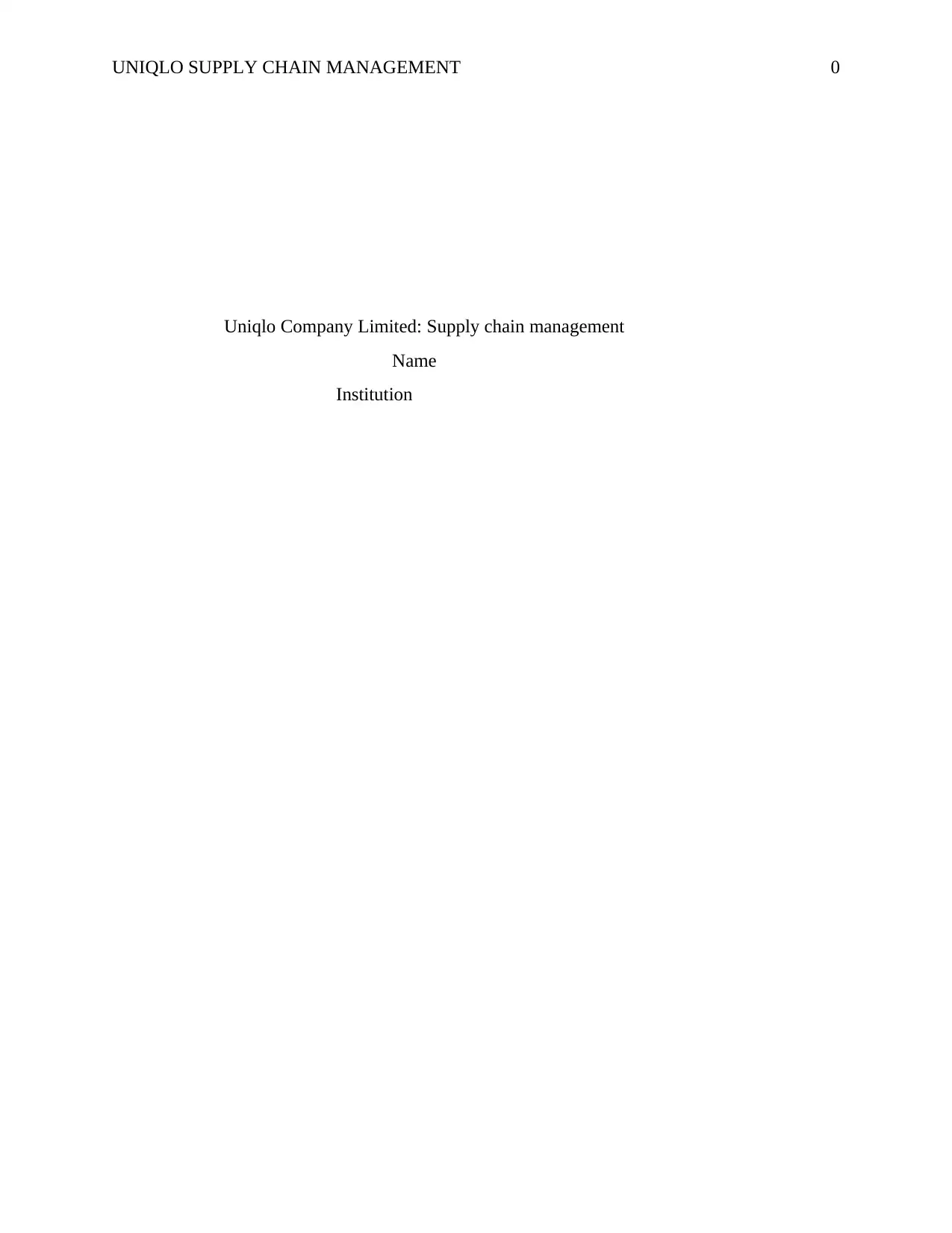
UNIQLO SUPPLY CHAIN MANAGEMENT 0
Uniqlo Company Limited: Supply chain management
Name
Institution
Uniqlo Company Limited: Supply chain management
Name
Institution
Paraphrase This Document
Need a fresh take? Get an instant paraphrase of this document with our AI Paraphraser
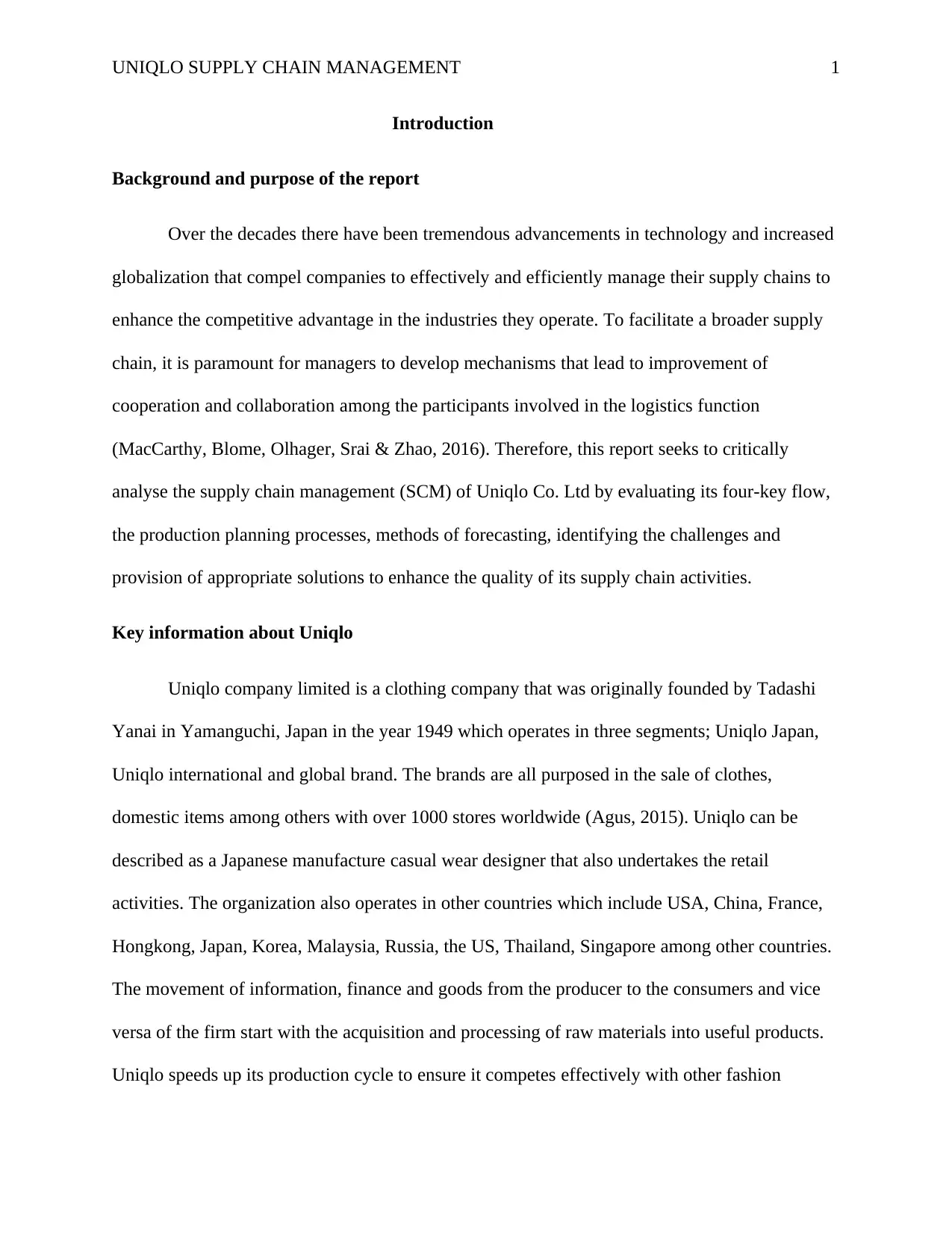
UNIQLO SUPPLY CHAIN MANAGEMENT 1
Introduction
Background and purpose of the report
Over the decades there have been tremendous advancements in technology and increased
globalization that compel companies to effectively and efficiently manage their supply chains to
enhance the competitive advantage in the industries they operate. To facilitate a broader supply
chain, it is paramount for managers to develop mechanisms that lead to improvement of
cooperation and collaboration among the participants involved in the logistics function
(MacCarthy, Blome, Olhager, Srai & Zhao, 2016). Therefore, this report seeks to critically
analyse the supply chain management (SCM) of Uniqlo Co. Ltd by evaluating its four-key flow,
the production planning processes, methods of forecasting, identifying the challenges and
provision of appropriate solutions to enhance the quality of its supply chain activities.
Key information about Uniqlo
Uniqlo company limited is a clothing company that was originally founded by Tadashi
Yanai in Yamanguchi, Japan in the year 1949 which operates in three segments; Uniqlo Japan,
Uniqlo international and global brand. The brands are all purposed in the sale of clothes,
domestic items among others with over 1000 stores worldwide (Agus, 2015). Uniqlo can be
described as a Japanese manufacture casual wear designer that also undertakes the retail
activities. The organization also operates in other countries which include USA, China, France,
Hongkong, Japan, Korea, Malaysia, Russia, the US, Thailand, Singapore among other countries.
The movement of information, finance and goods from the producer to the consumers and vice
versa of the firm start with the acquisition and processing of raw materials into useful products.
Uniqlo speeds up its production cycle to ensure it competes effectively with other fashion
Introduction
Background and purpose of the report
Over the decades there have been tremendous advancements in technology and increased
globalization that compel companies to effectively and efficiently manage their supply chains to
enhance the competitive advantage in the industries they operate. To facilitate a broader supply
chain, it is paramount for managers to develop mechanisms that lead to improvement of
cooperation and collaboration among the participants involved in the logistics function
(MacCarthy, Blome, Olhager, Srai & Zhao, 2016). Therefore, this report seeks to critically
analyse the supply chain management (SCM) of Uniqlo Co. Ltd by evaluating its four-key flow,
the production planning processes, methods of forecasting, identifying the challenges and
provision of appropriate solutions to enhance the quality of its supply chain activities.
Key information about Uniqlo
Uniqlo company limited is a clothing company that was originally founded by Tadashi
Yanai in Yamanguchi, Japan in the year 1949 which operates in three segments; Uniqlo Japan,
Uniqlo international and global brand. The brands are all purposed in the sale of clothes,
domestic items among others with over 1000 stores worldwide (Agus, 2015). Uniqlo can be
described as a Japanese manufacture casual wear designer that also undertakes the retail
activities. The organization also operates in other countries which include USA, China, France,
Hongkong, Japan, Korea, Malaysia, Russia, the US, Thailand, Singapore among other countries.
The movement of information, finance and goods from the producer to the consumers and vice
versa of the firm start with the acquisition and processing of raw materials into useful products.
Uniqlo speeds up its production cycle to ensure it competes effectively with other fashion
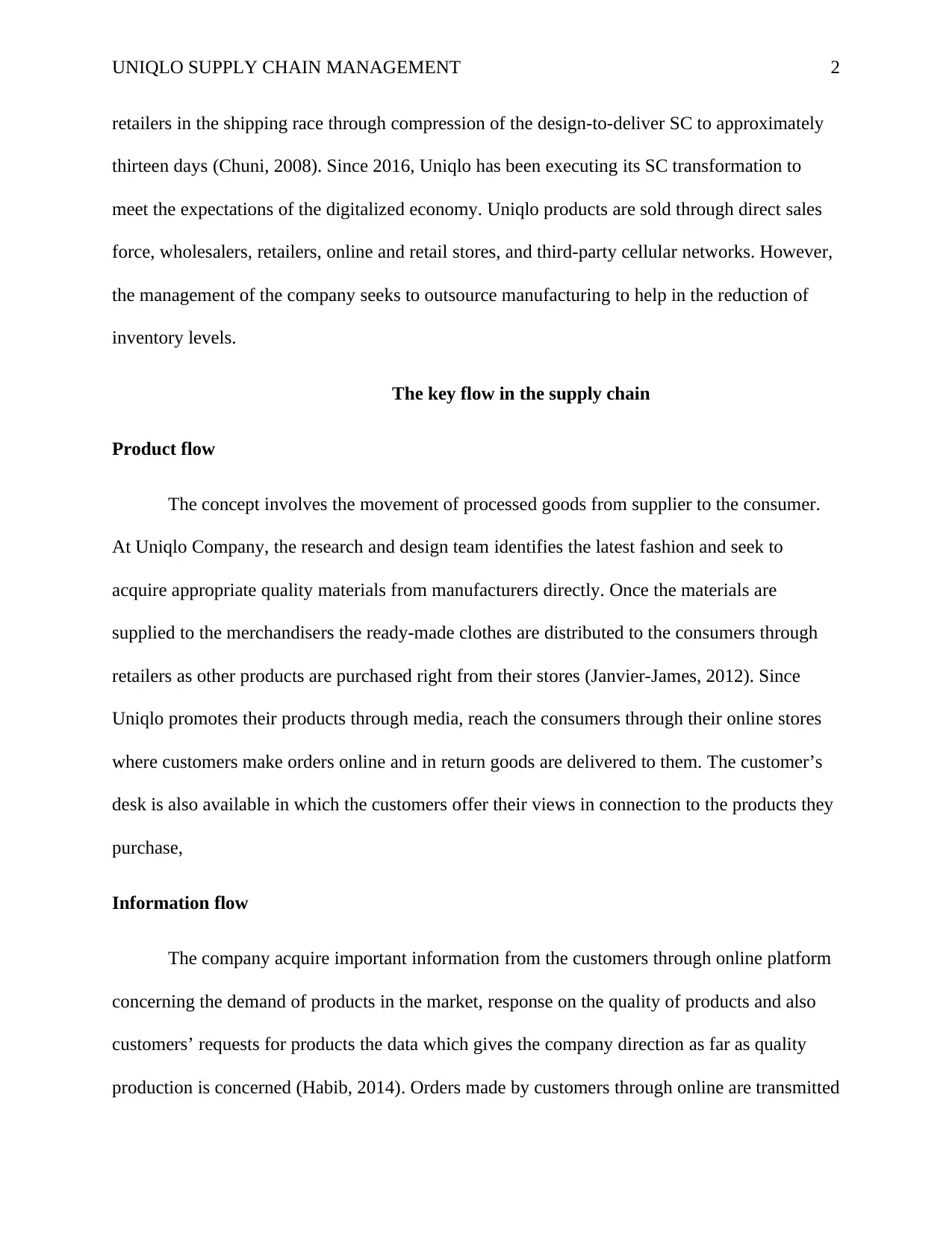
UNIQLO SUPPLY CHAIN MANAGEMENT 2
retailers in the shipping race through compression of the design-to-deliver SC to approximately
thirteen days (Chuni, 2008). Since 2016, Uniqlo has been executing its SC transformation to
meet the expectations of the digitalized economy. Uniqlo products are sold through direct sales
force, wholesalers, retailers, online and retail stores, and third-party cellular networks. However,
the management of the company seeks to outsource manufacturing to help in the reduction of
inventory levels.
The key flow in the supply chain
Product flow
The concept involves the movement of processed goods from supplier to the consumer.
At Uniqlo Company, the research and design team identifies the latest fashion and seek to
acquire appropriate quality materials from manufacturers directly. Once the materials are
supplied to the merchandisers the ready-made clothes are distributed to the consumers through
retailers as other products are purchased right from their stores (Janvier-James, 2012). Since
Uniqlo promotes their products through media, reach the consumers through their online stores
where customers make orders online and in return goods are delivered to them. The customer’s
desk is also available in which the customers offer their views in connection to the products they
purchase,
Information flow
The company acquire important information from the customers through online platform
concerning the demand of products in the market, response on the quality of products and also
customers’ requests for products the data which gives the company direction as far as quality
production is concerned (Habib, 2014). Orders made by customers through online are transmitted
retailers in the shipping race through compression of the design-to-deliver SC to approximately
thirteen days (Chuni, 2008). Since 2016, Uniqlo has been executing its SC transformation to
meet the expectations of the digitalized economy. Uniqlo products are sold through direct sales
force, wholesalers, retailers, online and retail stores, and third-party cellular networks. However,
the management of the company seeks to outsource manufacturing to help in the reduction of
inventory levels.
The key flow in the supply chain
Product flow
The concept involves the movement of processed goods from supplier to the consumer.
At Uniqlo Company, the research and design team identifies the latest fashion and seek to
acquire appropriate quality materials from manufacturers directly. Once the materials are
supplied to the merchandisers the ready-made clothes are distributed to the consumers through
retailers as other products are purchased right from their stores (Janvier-James, 2012). Since
Uniqlo promotes their products through media, reach the consumers through their online stores
where customers make orders online and in return goods are delivered to them. The customer’s
desk is also available in which the customers offer their views in connection to the products they
purchase,
Information flow
The company acquire important information from the customers through online platform
concerning the demand of products in the market, response on the quality of products and also
customers’ requests for products the data which gives the company direction as far as quality
production is concerned (Habib, 2014). Orders made by customers through online are transmitted
⊘ This is a preview!⊘
Do you want full access?
Subscribe today to unlock all pages.

Trusted by 1+ million students worldwide
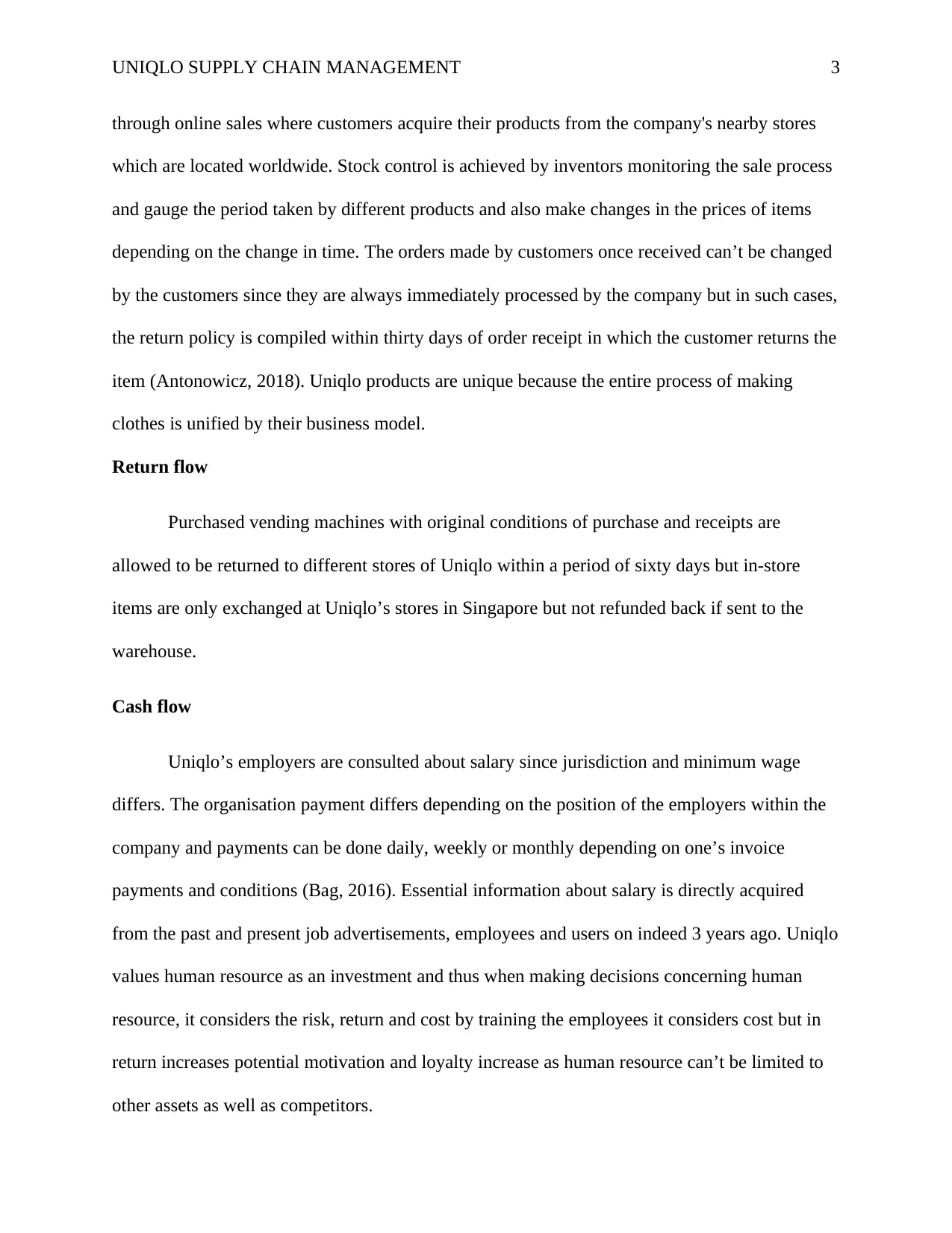
UNIQLO SUPPLY CHAIN MANAGEMENT 3
through online sales where customers acquire their products from the company's nearby stores
which are located worldwide. Stock control is achieved by inventors monitoring the sale process
and gauge the period taken by different products and also make changes in the prices of items
depending on the change in time. The orders made by customers once received can’t be changed
by the customers since they are always immediately processed by the company but in such cases,
the return policy is compiled within thirty days of order receipt in which the customer returns the
item (Antonowicz, 2018). Uniqlo products are unique because the entire process of making
clothes is unified by their business model.
Return flow
Purchased vending machines with original conditions of purchase and receipts are
allowed to be returned to different stores of Uniqlo within a period of sixty days but in-store
items are only exchanged at Uniqlo’s stores in Singapore but not refunded back if sent to the
warehouse.
Cash flow
Uniqlo’s employers are consulted about salary since jurisdiction and minimum wage
differs. The organisation payment differs depending on the position of the employers within the
company and payments can be done daily, weekly or monthly depending on one’s invoice
payments and conditions (Bag, 2016). Essential information about salary is directly acquired
from the past and present job advertisements, employees and users on indeed 3 years ago. Uniqlo
values human resource as an investment and thus when making decisions concerning human
resource, it considers the risk, return and cost by training the employees it considers cost but in
return increases potential motivation and loyalty increase as human resource can’t be limited to
other assets as well as competitors.
through online sales where customers acquire their products from the company's nearby stores
which are located worldwide. Stock control is achieved by inventors monitoring the sale process
and gauge the period taken by different products and also make changes in the prices of items
depending on the change in time. The orders made by customers once received can’t be changed
by the customers since they are always immediately processed by the company but in such cases,
the return policy is compiled within thirty days of order receipt in which the customer returns the
item (Antonowicz, 2018). Uniqlo products are unique because the entire process of making
clothes is unified by their business model.
Return flow
Purchased vending machines with original conditions of purchase and receipts are
allowed to be returned to different stores of Uniqlo within a period of sixty days but in-store
items are only exchanged at Uniqlo’s stores in Singapore but not refunded back if sent to the
warehouse.
Cash flow
Uniqlo’s employers are consulted about salary since jurisdiction and minimum wage
differs. The organisation payment differs depending on the position of the employers within the
company and payments can be done daily, weekly or monthly depending on one’s invoice
payments and conditions (Bag, 2016). Essential information about salary is directly acquired
from the past and present job advertisements, employees and users on indeed 3 years ago. Uniqlo
values human resource as an investment and thus when making decisions concerning human
resource, it considers the risk, return and cost by training the employees it considers cost but in
return increases potential motivation and loyalty increase as human resource can’t be limited to
other assets as well as competitors.
Paraphrase This Document
Need a fresh take? Get an instant paraphrase of this document with our AI Paraphraser
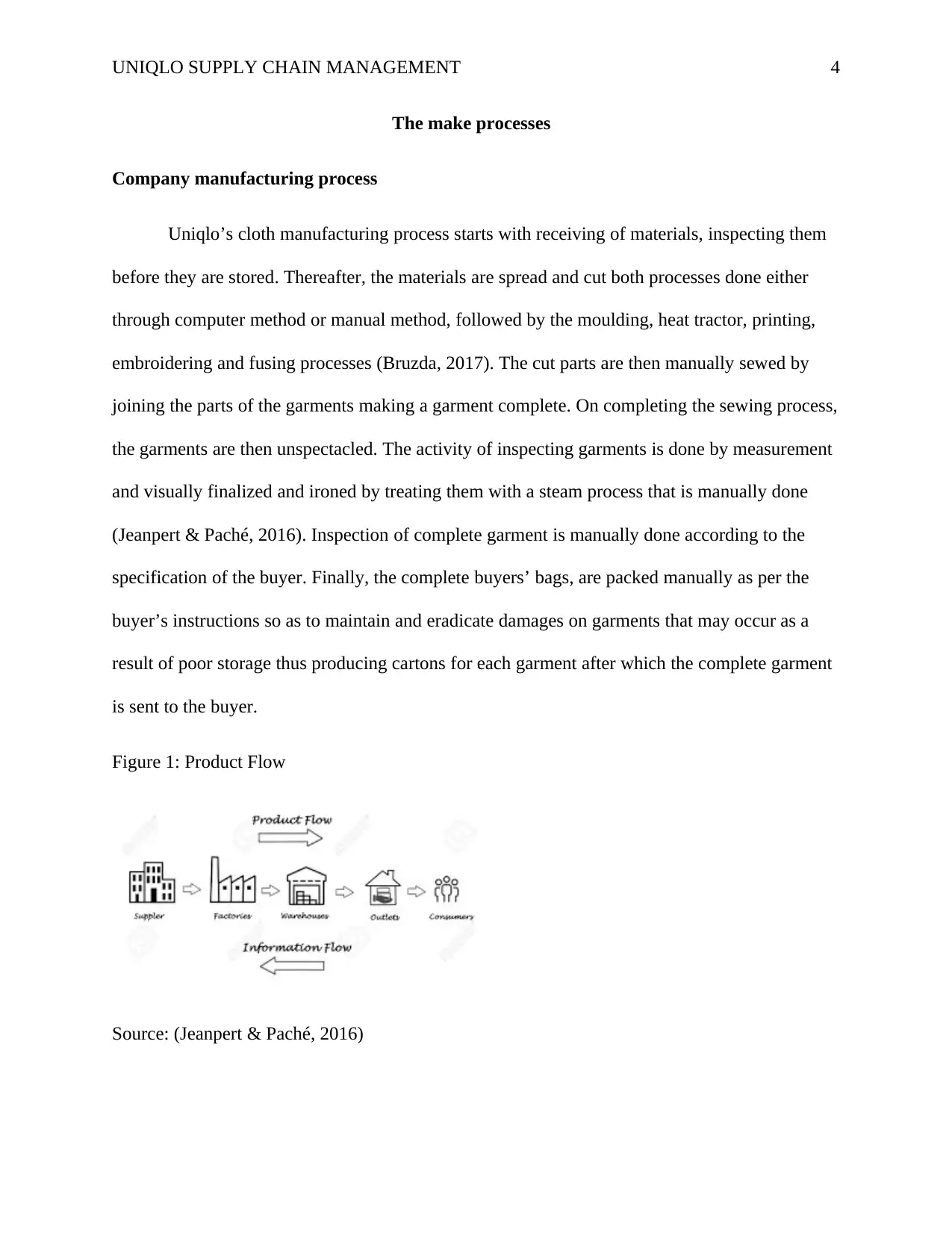
UNIQLO SUPPLY CHAIN MANAGEMENT 4
The make processes
Company manufacturing process
Uniqlo’s cloth manufacturing process starts with receiving of materials, inspecting them
before they are stored. Thereafter, the materials are spread and cut both processes done either
through computer method or manual method, followed by the moulding, heat tractor, printing,
embroidering and fusing processes (Bruzda, 2017). The cut parts are then manually sewed by
joining the parts of the garments making a garment complete. On completing the sewing process,
the garments are then unspectacled. The activity of inspecting garments is done by measurement
and visually finalized and ironed by treating them with a steam process that is manually done
(Jeanpert & Paché, 2016). Inspection of complete garment is manually done according to the
specification of the buyer. Finally, the complete buyers’ bags, are packed manually as per the
buyer’s instructions so as to maintain and eradicate damages on garments that may occur as a
result of poor storage thus producing cartons for each garment after which the complete garment
is sent to the buyer.
Figure 1: Product Flow
Source: (Jeanpert & Paché, 2016)
The make processes
Company manufacturing process
Uniqlo’s cloth manufacturing process starts with receiving of materials, inspecting them
before they are stored. Thereafter, the materials are spread and cut both processes done either
through computer method or manual method, followed by the moulding, heat tractor, printing,
embroidering and fusing processes (Bruzda, 2017). The cut parts are then manually sewed by
joining the parts of the garments making a garment complete. On completing the sewing process,
the garments are then unspectacled. The activity of inspecting garments is done by measurement
and visually finalized and ironed by treating them with a steam process that is manually done
(Jeanpert & Paché, 2016). Inspection of complete garment is manually done according to the
specification of the buyer. Finally, the complete buyers’ bags, are packed manually as per the
buyer’s instructions so as to maintain and eradicate damages on garments that may occur as a
result of poor storage thus producing cartons for each garment after which the complete garment
is sent to the buyer.
Figure 1: Product Flow
Source: (Jeanpert & Paché, 2016)
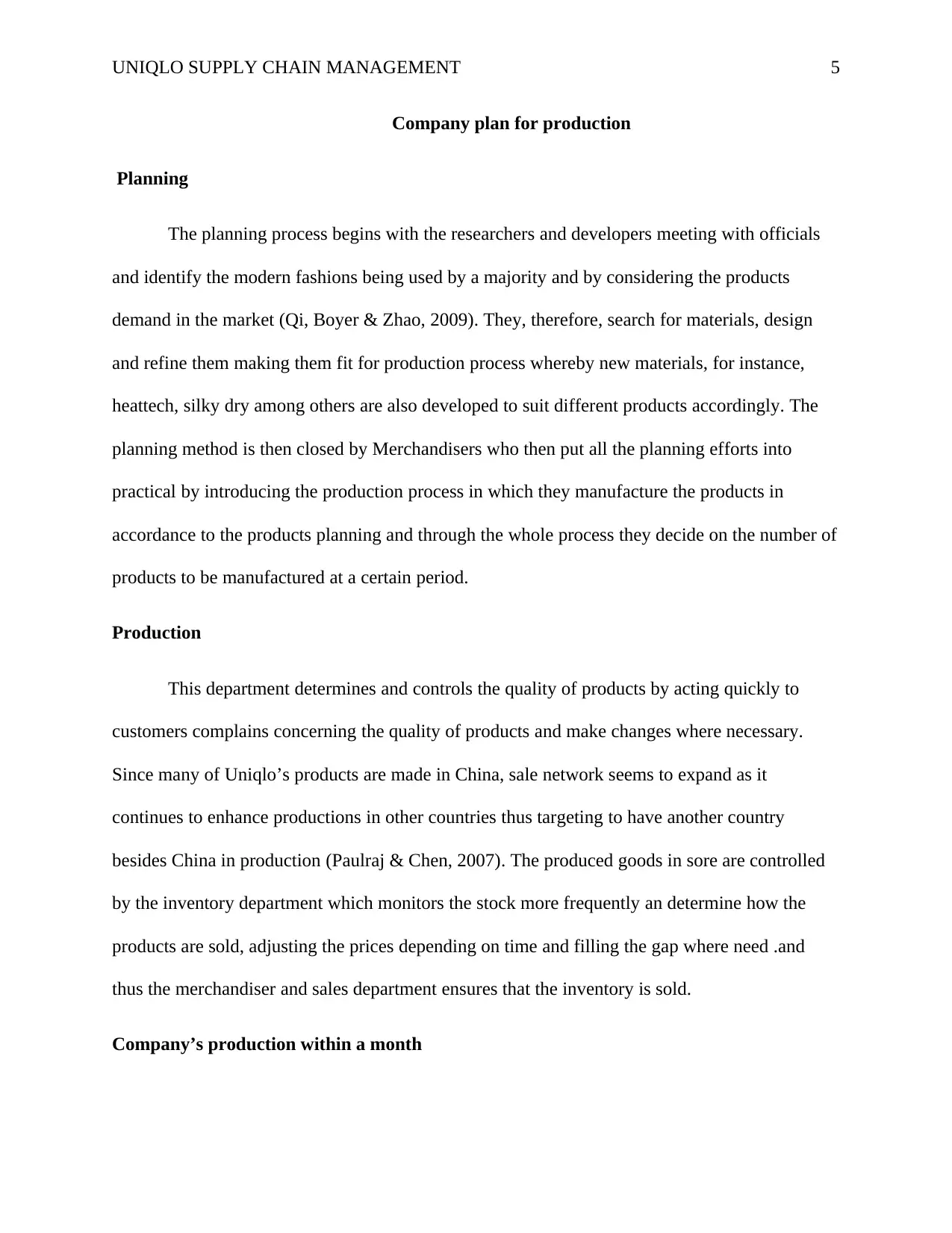
UNIQLO SUPPLY CHAIN MANAGEMENT 5
Company plan for production
Planning
The planning process begins with the researchers and developers meeting with officials
and identify the modern fashions being used by a majority and by considering the products
demand in the market (Qi, Boyer & Zhao, 2009). They, therefore, search for materials, design
and refine them making them fit for production process whereby new materials, for instance,
heattech, silky dry among others are also developed to suit different products accordingly. The
planning method is then closed by Merchandisers who then put all the planning efforts into
practical by introducing the production process in which they manufacture the products in
accordance to the products planning and through the whole process they decide on the number of
products to be manufactured at a certain period.
Production
This department determines and controls the quality of products by acting quickly to
customers complains concerning the quality of products and make changes where necessary.
Since many of Uniqlo’s products are made in China, sale network seems to expand as it
continues to enhance productions in other countries thus targeting to have another country
besides China in production (Paulraj & Chen, 2007). The produced goods in sore are controlled
by the inventory department which monitors the stock more frequently an determine how the
products are sold, adjusting the prices depending on time and filling the gap where need .and
thus the merchandiser and sales department ensures that the inventory is sold.
Company’s production within a month
Company plan for production
Planning
The planning process begins with the researchers and developers meeting with officials
and identify the modern fashions being used by a majority and by considering the products
demand in the market (Qi, Boyer & Zhao, 2009). They, therefore, search for materials, design
and refine them making them fit for production process whereby new materials, for instance,
heattech, silky dry among others are also developed to suit different products accordingly. The
planning method is then closed by Merchandisers who then put all the planning efforts into
practical by introducing the production process in which they manufacture the products in
accordance to the products planning and through the whole process they decide on the number of
products to be manufactured at a certain period.
Production
This department determines and controls the quality of products by acting quickly to
customers complains concerning the quality of products and make changes where necessary.
Since many of Uniqlo’s products are made in China, sale network seems to expand as it
continues to enhance productions in other countries thus targeting to have another country
besides China in production (Paulraj & Chen, 2007). The produced goods in sore are controlled
by the inventory department which monitors the stock more frequently an determine how the
products are sold, adjusting the prices depending on time and filling the gap where need .and
thus the merchandiser and sales department ensures that the inventory is sold.
Company’s production within a month
⊘ This is a preview!⊘
Do you want full access?
Subscribe today to unlock all pages.

Trusted by 1+ million students worldwide
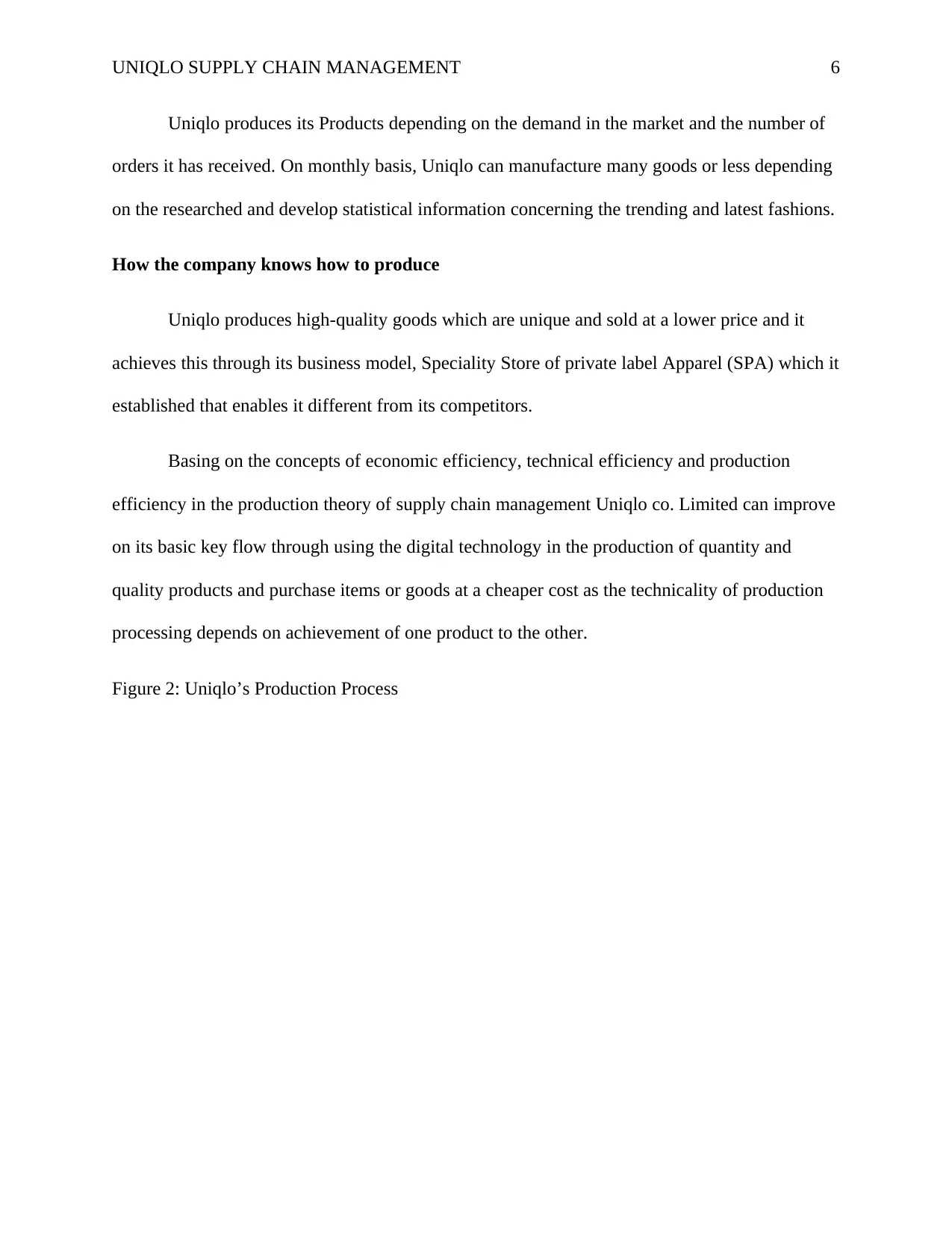
UNIQLO SUPPLY CHAIN MANAGEMENT 6
Uniqlo produces its Products depending on the demand in the market and the number of
orders it has received. On monthly basis, Uniqlo can manufacture many goods or less depending
on the researched and develop statistical information concerning the trending and latest fashions.
How the company knows how to produce
Uniqlo produces high-quality goods which are unique and sold at a lower price and it
achieves this through its business model, Speciality Store of private label Apparel (SPA) which it
established that enables it different from its competitors.
Basing on the concepts of economic efficiency, technical efficiency and production
efficiency in the production theory of supply chain management Uniqlo co. Limited can improve
on its basic key flow through using the digital technology in the production of quantity and
quality products and purchase items or goods at a cheaper cost as the technicality of production
processing depends on achievement of one product to the other.
Figure 2: Uniqlo’s Production Process
Uniqlo produces its Products depending on the demand in the market and the number of
orders it has received. On monthly basis, Uniqlo can manufacture many goods or less depending
on the researched and develop statistical information concerning the trending and latest fashions.
How the company knows how to produce
Uniqlo produces high-quality goods which are unique and sold at a lower price and it
achieves this through its business model, Speciality Store of private label Apparel (SPA) which it
established that enables it different from its competitors.
Basing on the concepts of economic efficiency, technical efficiency and production
efficiency in the production theory of supply chain management Uniqlo co. Limited can improve
on its basic key flow through using the digital technology in the production of quantity and
quality products and purchase items or goods at a cheaper cost as the technicality of production
processing depends on achievement of one product to the other.
Figure 2: Uniqlo’s Production Process
Paraphrase This Document
Need a fresh take? Get an instant paraphrase of this document with our AI Paraphraser
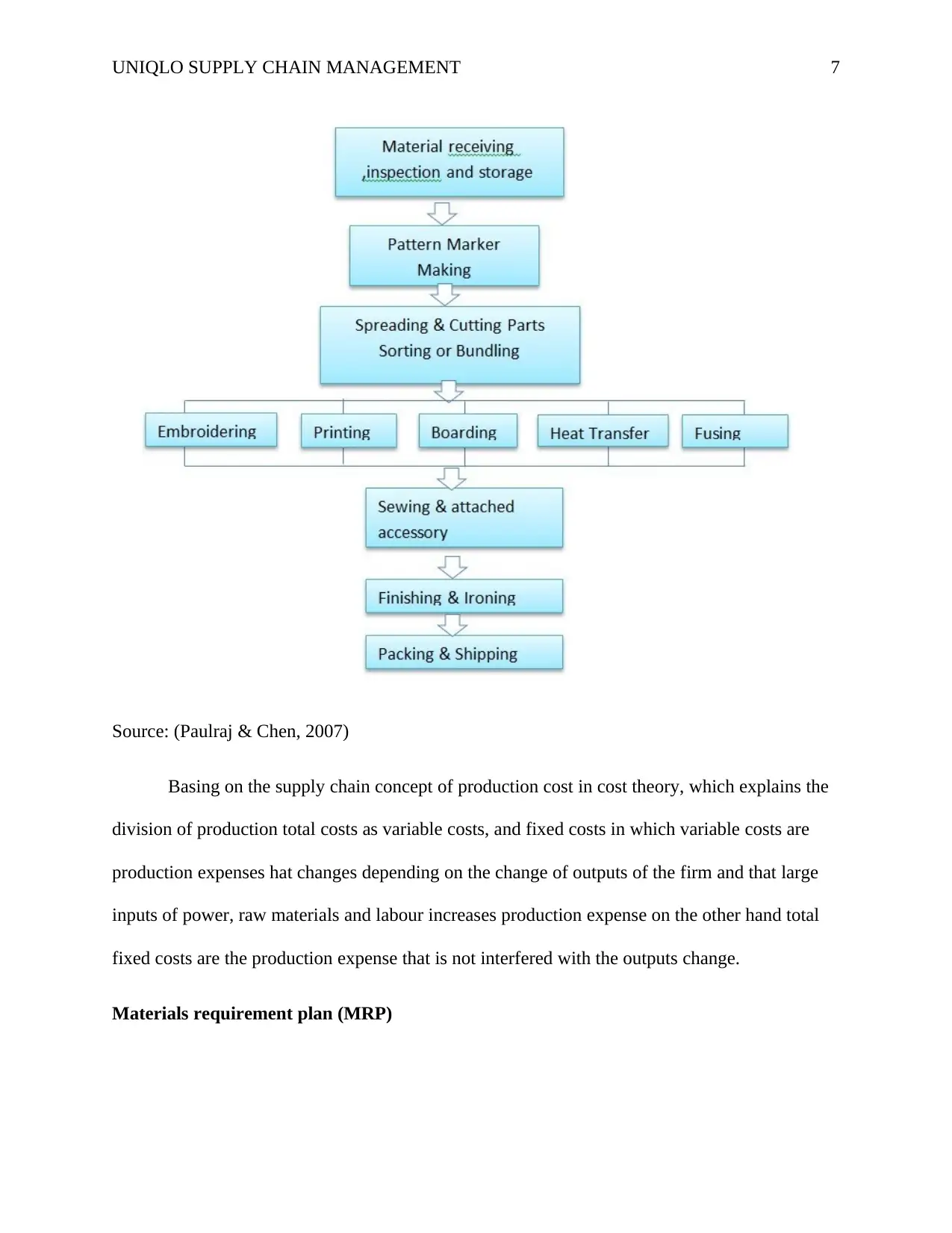
UNIQLO SUPPLY CHAIN MANAGEMENT 7
Source: (Paulraj & Chen, 2007)
Basing on the supply chain concept of production cost in cost theory, which explains the
division of production total costs as variable costs, and fixed costs in which variable costs are
production expenses hat changes depending on the change of outputs of the firm and that large
inputs of power, raw materials and labour increases production expense on the other hand total
fixed costs are the production expense that is not interfered with the outputs change.
Materials requirement plan (MRP)
Source: (Paulraj & Chen, 2007)
Basing on the supply chain concept of production cost in cost theory, which explains the
division of production total costs as variable costs, and fixed costs in which variable costs are
production expenses hat changes depending on the change of outputs of the firm and that large
inputs of power, raw materials and labour increases production expense on the other hand total
fixed costs are the production expense that is not interfered with the outputs change.
Materials requirement plan (MRP)
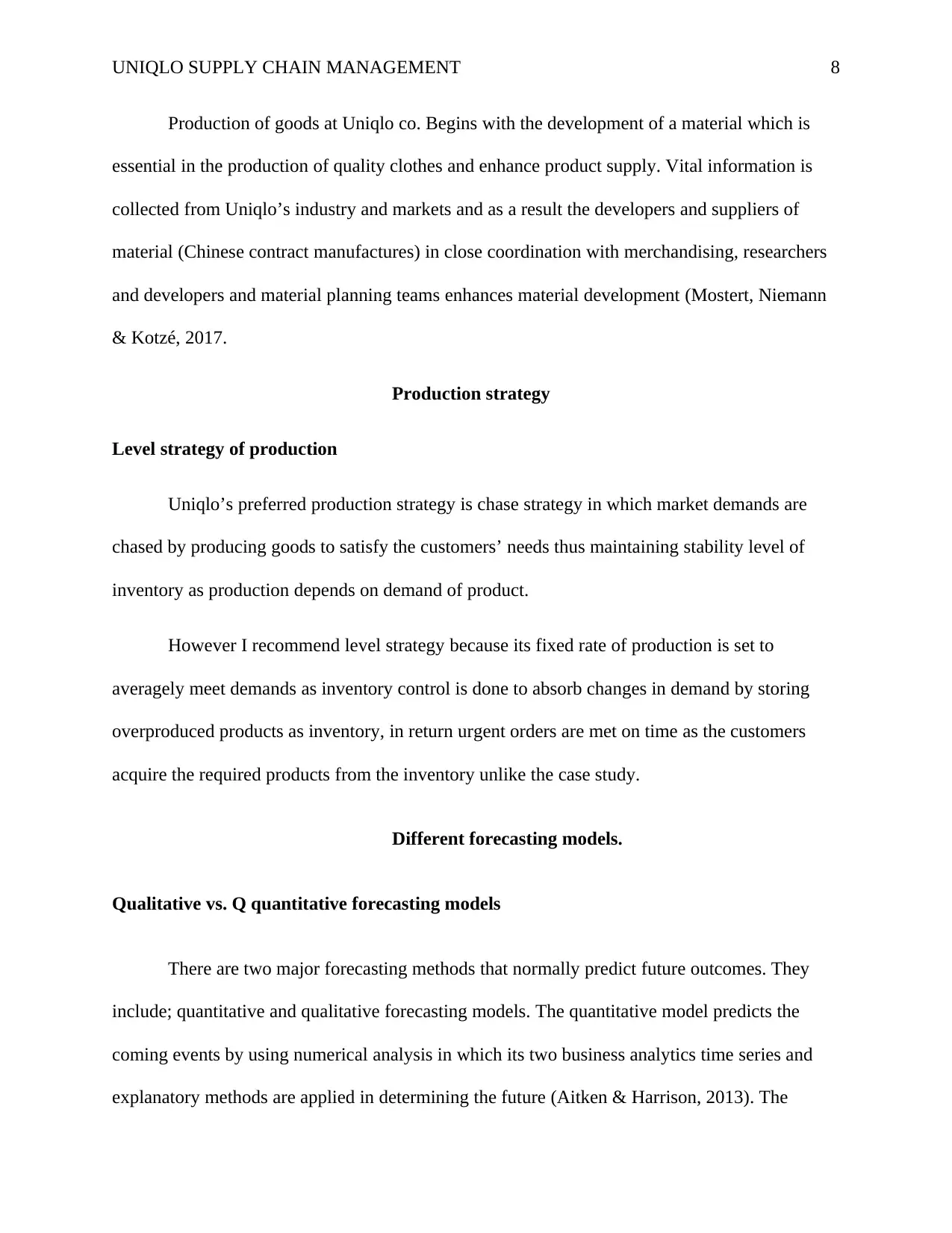
UNIQLO SUPPLY CHAIN MANAGEMENT 8
Production of goods at Uniqlo co. Begins with the development of a material which is
essential in the production of quality clothes and enhance product supply. Vital information is
collected from Uniqlo’s industry and markets and as a result the developers and suppliers of
material (Chinese contract manufactures) in close coordination with merchandising, researchers
and developers and material planning teams enhances material development (Mostert, Niemann
& Kotzé, 2017.
Production strategy
Level strategy of production
Uniqlo’s preferred production strategy is chase strategy in which market demands are
chased by producing goods to satisfy the customers’ needs thus maintaining stability level of
inventory as production depends on demand of product.
However I recommend level strategy because its fixed rate of production is set to
averagely meet demands as inventory control is done to absorb changes in demand by storing
overproduced products as inventory, in return urgent orders are met on time as the customers
acquire the required products from the inventory unlike the case study.
Different forecasting models.
Qualitative vs. Q quantitative forecasting models
There are two major forecasting methods that normally predict future outcomes. They
include; quantitative and qualitative forecasting models. The quantitative model predicts the
coming events by using numerical analysis in which its two business analytics time series and
explanatory methods are applied in determining the future (Aitken & Harrison, 2013). The
Production of goods at Uniqlo co. Begins with the development of a material which is
essential in the production of quality clothes and enhance product supply. Vital information is
collected from Uniqlo’s industry and markets and as a result the developers and suppliers of
material (Chinese contract manufactures) in close coordination with merchandising, researchers
and developers and material planning teams enhances material development (Mostert, Niemann
& Kotzé, 2017.
Production strategy
Level strategy of production
Uniqlo’s preferred production strategy is chase strategy in which market demands are
chased by producing goods to satisfy the customers’ needs thus maintaining stability level of
inventory as production depends on demand of product.
However I recommend level strategy because its fixed rate of production is set to
averagely meet demands as inventory control is done to absorb changes in demand by storing
overproduced products as inventory, in return urgent orders are met on time as the customers
acquire the required products from the inventory unlike the case study.
Different forecasting models.
Qualitative vs. Q quantitative forecasting models
There are two major forecasting methods that normally predict future outcomes. They
include; quantitative and qualitative forecasting models. The quantitative model predicts the
coming events by using numerical analysis in which its two business analytics time series and
explanatory methods are applied in determining the future (Aitken & Harrison, 2013). The
⊘ This is a preview!⊘
Do you want full access?
Subscribe today to unlock all pages.

Trusted by 1+ million students worldwide
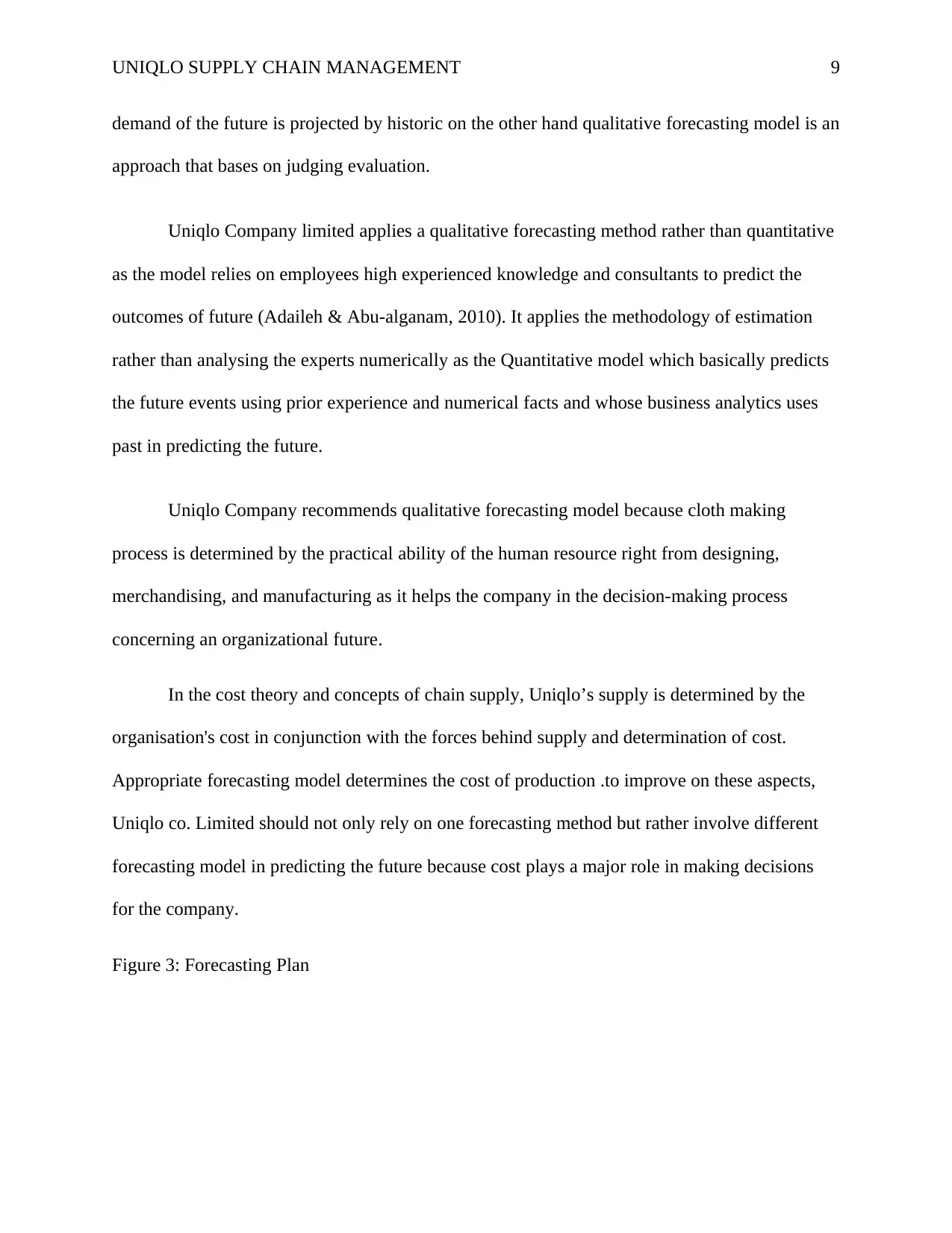
UNIQLO SUPPLY CHAIN MANAGEMENT 9
demand of the future is projected by historic on the other hand qualitative forecasting model is an
approach that bases on judging evaluation.
Uniqlo Company limited applies a qualitative forecasting method rather than quantitative
as the model relies on employees high experienced knowledge and consultants to predict the
outcomes of future (Adaileh & Abu-alganam, 2010). It applies the methodology of estimation
rather than analysing the experts numerically as the Quantitative model which basically predicts
the future events using prior experience and numerical facts and whose business analytics uses
past in predicting the future.
Uniqlo Company recommends qualitative forecasting model because cloth making
process is determined by the practical ability of the human resource right from designing,
merchandising, and manufacturing as it helps the company in the decision-making process
concerning an organizational future.
In the cost theory and concepts of chain supply, Uniqlo’s supply is determined by the
organisation's cost in conjunction with the forces behind supply and determination of cost.
Appropriate forecasting model determines the cost of production .to improve on these aspects,
Uniqlo co. Limited should not only rely on one forecasting method but rather involve different
forecasting model in predicting the future because cost plays a major role in making decisions
for the company.
Figure 3: Forecasting Plan
demand of the future is projected by historic on the other hand qualitative forecasting model is an
approach that bases on judging evaluation.
Uniqlo Company limited applies a qualitative forecasting method rather than quantitative
as the model relies on employees high experienced knowledge and consultants to predict the
outcomes of future (Adaileh & Abu-alganam, 2010). It applies the methodology of estimation
rather than analysing the experts numerically as the Quantitative model which basically predicts
the future events using prior experience and numerical facts and whose business analytics uses
past in predicting the future.
Uniqlo Company recommends qualitative forecasting model because cloth making
process is determined by the practical ability of the human resource right from designing,
merchandising, and manufacturing as it helps the company in the decision-making process
concerning an organizational future.
In the cost theory and concepts of chain supply, Uniqlo’s supply is determined by the
organisation's cost in conjunction with the forces behind supply and determination of cost.
Appropriate forecasting model determines the cost of production .to improve on these aspects,
Uniqlo co. Limited should not only rely on one forecasting method but rather involve different
forecasting model in predicting the future because cost plays a major role in making decisions
for the company.
Figure 3: Forecasting Plan
Paraphrase This Document
Need a fresh take? Get an instant paraphrase of this document with our AI Paraphraser
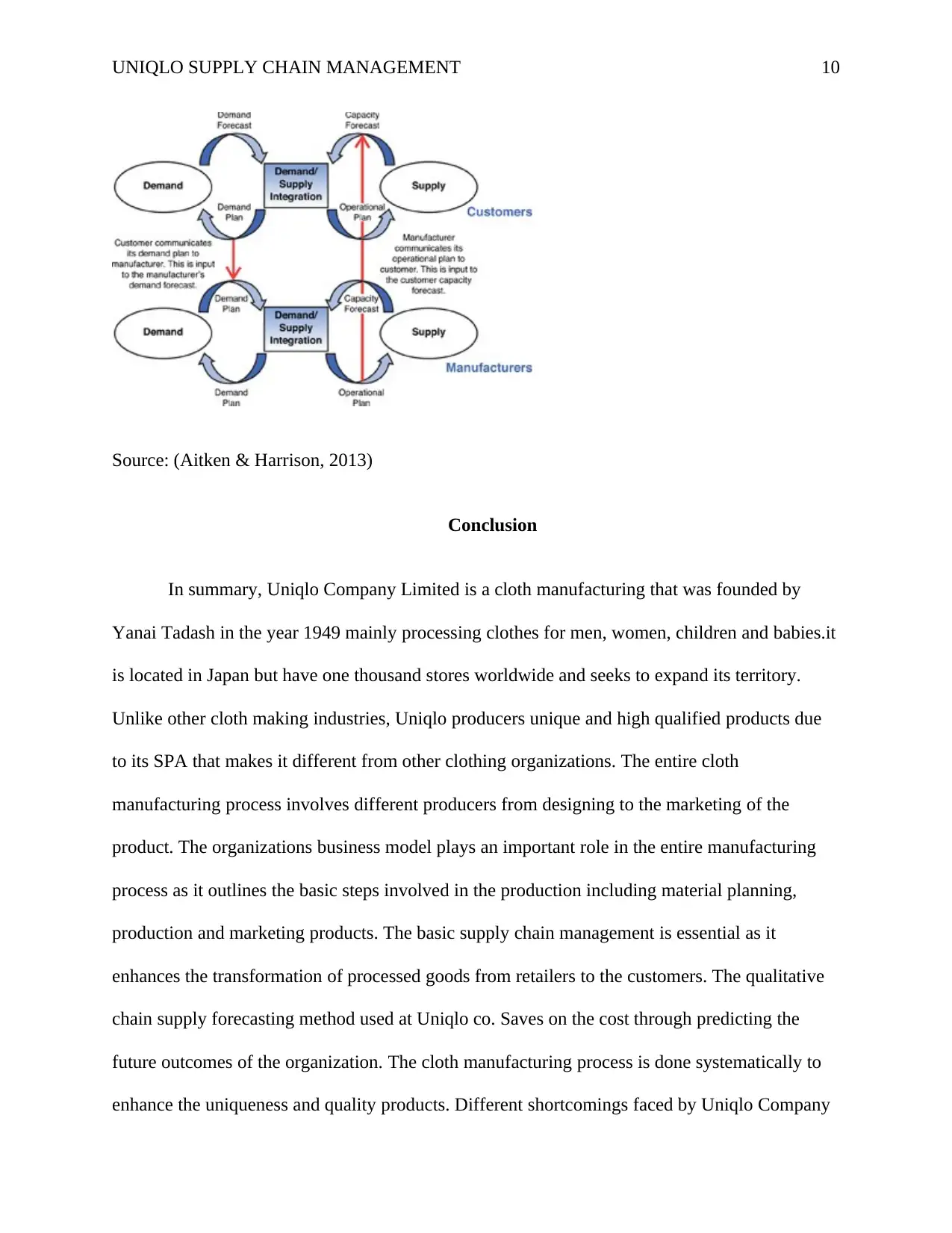
UNIQLO SUPPLY CHAIN MANAGEMENT 10
Source: (Aitken & Harrison, 2013)
Conclusion
In summary, Uniqlo Company Limited is a cloth manufacturing that was founded by
Yanai Tadash in the year 1949 mainly processing clothes for men, women, children and babies.it
is located in Japan but have one thousand stores worldwide and seeks to expand its territory.
Unlike other cloth making industries, Uniqlo producers unique and high qualified products due
to its SPA that makes it different from other clothing organizations. The entire cloth
manufacturing process involves different producers from designing to the marketing of the
product. The organizations business model plays an important role in the entire manufacturing
process as it outlines the basic steps involved in the production including material planning,
production and marketing products. The basic supply chain management is essential as it
enhances the transformation of processed goods from retailers to the customers. The qualitative
chain supply forecasting method used at Uniqlo co. Saves on the cost through predicting the
future outcomes of the organization. The cloth manufacturing process is done systematically to
enhance the uniqueness and quality products. Different shortcomings faced by Uniqlo Company
Source: (Aitken & Harrison, 2013)
Conclusion
In summary, Uniqlo Company Limited is a cloth manufacturing that was founded by
Yanai Tadash in the year 1949 mainly processing clothes for men, women, children and babies.it
is located in Japan but have one thousand stores worldwide and seeks to expand its territory.
Unlike other cloth making industries, Uniqlo producers unique and high qualified products due
to its SPA that makes it different from other clothing organizations. The entire cloth
manufacturing process involves different producers from designing to the marketing of the
product. The organizations business model plays an important role in the entire manufacturing
process as it outlines the basic steps involved in the production including material planning,
production and marketing products. The basic supply chain management is essential as it
enhances the transformation of processed goods from retailers to the customers. The qualitative
chain supply forecasting method used at Uniqlo co. Saves on the cost through predicting the
future outcomes of the organization. The cloth manufacturing process is done systematically to
enhance the uniqueness and quality products. Different shortcomings faced by Uniqlo Company
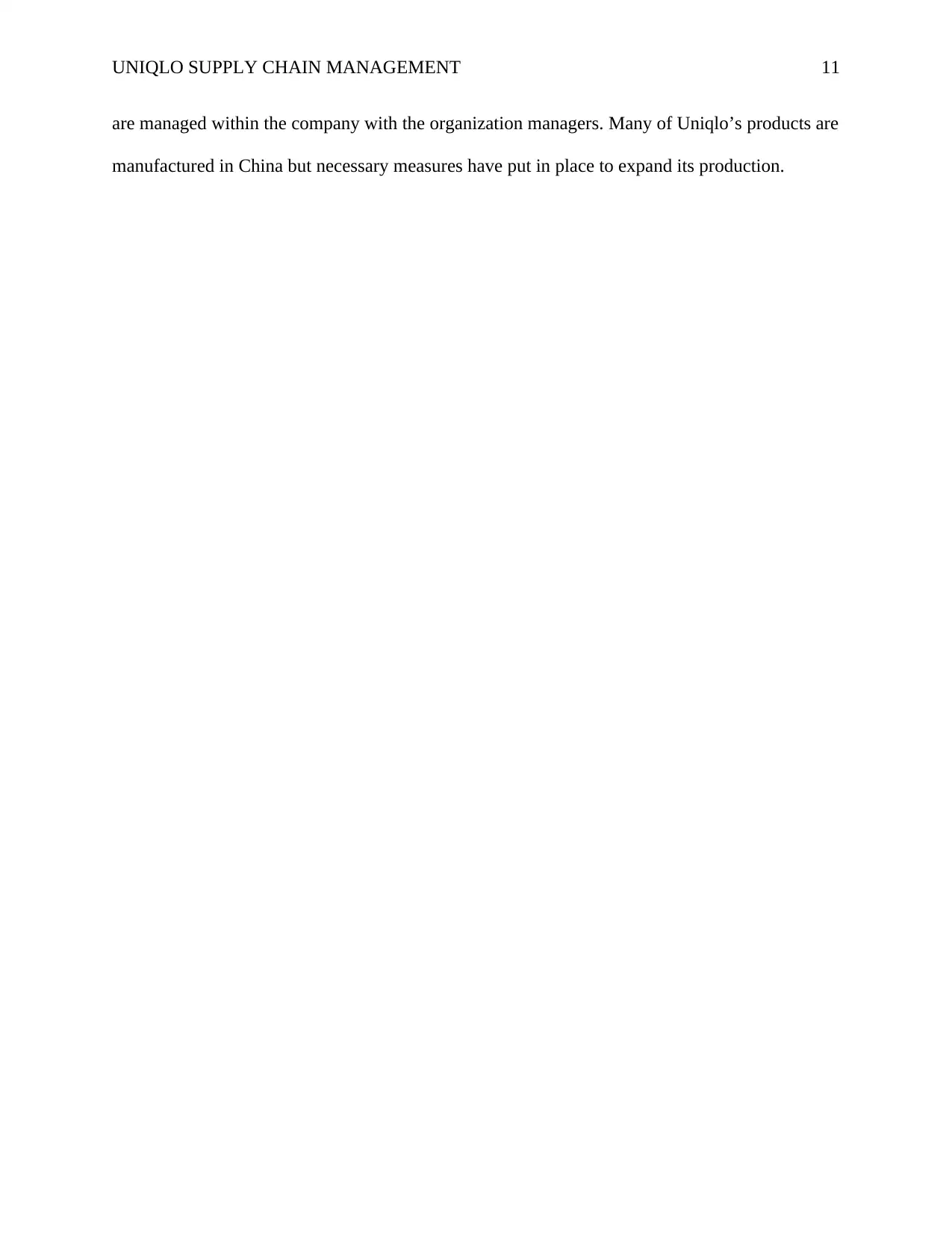
UNIQLO SUPPLY CHAIN MANAGEMENT 11
are managed within the company with the organization managers. Many of Uniqlo’s products are
manufactured in China but necessary measures have put in place to expand its production.
are managed within the company with the organization managers. Many of Uniqlo’s products are
manufactured in China but necessary measures have put in place to expand its production.
⊘ This is a preview!⊘
Do you want full access?
Subscribe today to unlock all pages.

Trusted by 1+ million students worldwide
1 out of 14
Related Documents
Your All-in-One AI-Powered Toolkit for Academic Success.
+13062052269
info@desklib.com
Available 24*7 on WhatsApp / Email
![[object Object]](/_next/static/media/star-bottom.7253800d.svg)
Unlock your academic potential
Copyright © 2020–2025 A2Z Services. All Rights Reserved. Developed and managed by ZUCOL.





